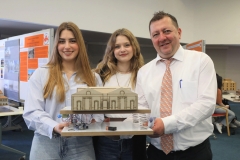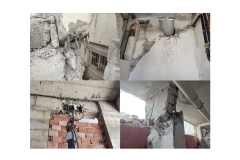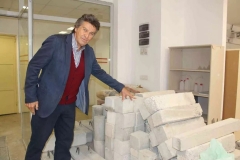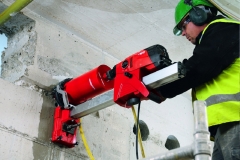
FACULTY OF ENGINEERING
Department of Civil Engineering
CIVE 412 | Course Introduction and Application Information
| Course Name |
Advanced Steel Design
|
|
Code
|
Semester
|
Theory
(hour/week) |
Application/Lab
(hour/week) |
Local Credits
|
ECTS
|
|
CIVE 412
|
Fall/Spring
|
3
|
0
|
3
|
6
|
| Prerequisites |
|
|||||||
| Course Language |
English
|
|||||||
| Course Type |
Service Course
|
|||||||
| Course Level |
First Cycle
|
|||||||
| Mode of Delivery | - | |||||||
| Teaching Methods and Techniques of the Course | - | |||||||
| Course Coordinator | - | |||||||
| Course Lecturer(s) | - | |||||||
| Assistant(s) | - | |||||||
| Course Objectives | To perform structural design of steel elements under combined loading, composite beams, plate girders, and connections |
| Learning Outcomes |
The students who succeeded in this course;
|
| Course Description | Review of basic steel design, second order analysis and members under combined axial load and bending, composite beams, plate girders, connections. |
|
|
Core Courses | |
| Major Area Courses |
X
|
|
| Supportive Courses | ||
| Media and Management Skills Courses | ||
| Transferable Skill Courses |
WEEKLY SUBJECTS AND RELATED PREPARATION STUDIES
| Week | Subjects | Related Preparation |
| 1 | Introduction and review of basic steel design | Chapter-1: 1.1-1.7; 2.1-2.2; “Structural Steel Design LRFD Method,” J. C. McCormac, Stephen F. Csernak, 5th Ed., Prentice Hall, 2011 |
| 2 | Second order analysis | Chapter-11: 11.1-11.4; “Structural Steel Design LRFD Method,” J. C. McCormac, Stephen F. Csernak, 5th Ed., Prentice Hall, 2011 |
| 3 | Members under combined axial load and bending | Chapter-11: 11.2-11.5; “Structural Steel Design LRFD Method,” J. C. McCormac, Stephen F. Csernak, 5th Ed., Prentice Hall, 2011 |
| 4 | Members under combined axial load and bending | Chapter-11: 11.5-11.6; “Structural Steel Design LRFD Method,” J. C. McCormac, Stephen F. Csernak, 5th Ed., Prentice Hall, 2011 |
| 5 | Members under combined axial load and bending | Chapter-11: 11.6-11.7; “Structural Steel Design LRFD Method,” J. C. McCormac, Stephen F. Csernak, 5th Ed., Prentice Hall, 2011 |
| 6 | Composite beams | Chapter-16: 16.1-16.4; “Structural Steel Design LRFD Method,” J. C. McCormac, Stephen F. Csernak, 5th Ed., Prentice Hall, 2011 |
| 7 | Review | Chapter-1: 1.1-1.7; 2.1-2.2; 11.1-11.7;“Structural Steel Design LRFD Method,” J. C. McCormac, Stephen F. Csernak, 5th Ed., Prentice Hall, 2011 |
| 8 | Composite beams | Chapter-16: 16.4-16.7; “Structural Steel Design LRFD Method,” J. C. McCormac, Stephen F. Csernak, 5th Ed., Prentice Hall, 2011 |
| 9 | Composite beams | Chapter-16: 16.7-16.11; “Structural Steel Design LRFD Method,” J. C. McCormac, Stephen F. Csernak, 5th Ed., Prentice Hall, 2011 |
| 10 | Plate girders | Chapter-18: 18.1-18.4; “Structural Steel Design LRFD Method,” J. C. McCormac, Stephen F. Csernak, 5th Ed., Prentice Hall, 2011 |
| 11 | Plate girders | Chapter-18: 18.4-18.9; “Structural Steel Design LRFD Method,” J. C. McCormac, Stephen F. Csernak, 5th Ed., Prentice Hall, 2011 |
| 12 | Connections | Chapter-3: 3.1-3.7; “Structural Steel Design LRFD Method,” J. C. McCormac, Stephen F. Csernak, 5th Ed., Prentice Hall, 2011 |
| 13 | Connections | Chapter-12: 12.1-12.14; “Structural Steel Design LRFD Method,” J. C. McCormac, Stephen F. Csernak, 5th Ed., Prentice Hall, 2011 |
| 14 | Connections | Chapter-14: 14.1-14.17; “Structural Steel Design LRFD Method,” J. C. McCormac, Stephen F. Csernak, 5th Ed., Prentice Hall, 2011 |
| 15 | Review | Chapter-1: 1.1-1.7; 2.1-2.2; 11.1-11.7; 16-1-16.11; 18.1-18.9; 3.1-3.7; 12.1-12.14; 14.1-14.17; “Structural Steel Design LRFD Method,” J. C. McCormac, Stephen F. Csernak, 5th Ed., Prentice Hall, 2011 |
| 16 | Final | Chapter-1: 1.1-1.7; 2.1-2.2; “Structural Steel Design LRFD Method,” J. C. McCormac, Stephen F. Csernak, 5th Ed., Prentice Hall, 2011 |
| Course Notes/Textbooks | “Structural Steel Design, Jack C. McCormac, Stephen F. Csernak, 5th Ed., Prentice Hall, 2011 |
| Suggested Readings/Materials | Turkish Steel Code; AISC Steel Manual, 2015 |
EVALUATION SYSTEM
| Semester Activities | Number | Weigthing |
| Participation | ||
| Laboratory / Application | ||
| Field Work | ||
| Quizzes / Studio Critiques | ||
| Portfolio | ||
| Homework / Assignments |
7
|
30
|
| Presentation / Jury | ||
| Project |
1
|
20
|
| Seminar / Workshop | ||
| Oral Exams | ||
| Midterm |
1
|
20
|
| Final Exam |
1
|
30
|
| Total |
| Weighting of Semester Activities on the Final Grade |
70
|
|
| Weighting of End-of-Semester Activities on the Final Grade |
30
|
|
| Total |
ECTS / WORKLOAD TABLE
| Semester Activities | Number | Duration (Hours) | Workload |
|---|---|---|---|
| Theoretical Course Hours (Including exam week: 16 x total hours) |
16
|
3
|
48
|
| Laboratory / Application Hours (Including exam week: '.16.' x total hours) |
16
|
0
|
|
| Study Hours Out of Class |
16
|
2
|
32
|
| Field Work |
0
|
||
| Quizzes / Studio Critiques |
0
|
||
| Portfolio |
0
|
||
| Homework / Assignments |
7
|
4
|
28
|
| Presentation / Jury |
0
|
||
| Project |
1
|
30
|
30
|
| Seminar / Workshop |
0
|
||
| Oral Exam |
0
|
||
| Midterms |
1
|
20
|
20
|
| Final Exam |
1
|
22
|
22
|
| Total |
180
|
COURSE LEARNING OUTCOMES AND PROGRAM QUALIFICATIONS RELATIONSHIP
|
#
|
Program Competencies/Outcomes |
* Contribution Level
|
||||
|
1
|
2
|
3
|
4
|
5
|
||
| 1 | To have adequate knowledge in Mathematics, Science and Civil Engineering; to be able to use theoretical and applied information in these areas on complex engineering problems. |
|||||
| 2 | To be able to identify, define, formulate, and solve complex Civil Engineering problems; to be able to select and apply proper analysis and modeling methods for this purpose. |
X | ||||
| 3 | To be able to design a complex system, process, device or product under realistic constraints and conditions, in such a way as to meet the requirements; to be able to apply modern design methods for this purpose. |
X | ||||
| 4 | To be able to devise, select, and use modern techniques and tools needed for analysis and solution of complex problems in engineering applications. |
|||||
| 5 | To be able to design and conduct experiments, gather data, analyze and interpret results for investigating complex engineering problems or Civil Engineering research topics. |
|||||
| 6 | To be able to work efficiently in Civil Engineering disciplinary and multi-disciplinary teams; to be able to work individually. |
|||||
| 7 | To be able to communicate effectively in Turkish, both orally and in writing; to be able to author and comprehend written reports, to be able to prepare design and implementation reports, to present effectively, to be able to give and receive clear and comprehensible instructions. |
|||||
| 8 | To have knowledge about global and social impact of engineering practices on health, environment, and safety; to have knowledge about contemporary issues as they pertain to engineering; to be aware of the legal ramifications of engineering solutions. |
|||||
| 9 | To be aware of ethical behavior, professional and ethical responsibility; to have knowledge about standards utilized in engineering applications. |
|||||
| 10 | To have knowledge about industrial practices such as project management, risk management, and change management; to have awareness of entrepreneurship and innovation; to have knowledge about sustainable development. |
|||||
| 11 | To be able to collect data in the area of Civil Engineering, and to be able to communicate with colleagues in a foreign language; |
X | ||||
| 12 | To be able to speak a second foreign language at a medium level of fluency efficiently. |
|||||
| 13 | To recognize the need for lifelong learning; to be able to access information, to be able to stay current with developments in science and technology; to be able to relate the knowledge accumulated throughout the human history to Civil Engineering. |
|||||
*1 Lowest, 2 Low, 3 Average, 4 High, 5 Highest
NEWS |ALL NEWS

They examined building, showcased their models
Izmir University of Economics (IUE) Department of Civil Engineering and Architecture students examined 58 buildings in Izmir in terms of earthquake resistance

Photos of neglect
Asst. Prof. Dr. Egemen Sönmez, Lecturer at Department of Civil Engineering, Izmir University of Economics (IUE), went to the earthquake zone with

Exterior additions on buildings: cause for concern
Prof. Dr. Celalettin Kozanoğlu, Head of Department of Civil Engineering, Izmir University of Economics (IUE), warned about the water tanks placed on

We should take advantage of industrial building technology
Building tests and urban transformation works gained momentum throughout Turkey after the earthquake disaster, the epicenter of which was Kahramanmaraş and killed

Vital warnings in building inspections
After the earthquake disaster, the epicenter of which was Kahramanmaraş and which caused destruction in 10 cities, thousands of citizens rushed to

Negligence, not the soil, demolishes
Prof. Dr. Celalettin Kozanoğlu, Head of Department of Civil Engineering, Izmir University of Economics (IUE), stated that many buildings that were destroyed

‘Firewall’ project
IUE Rector Prof. Dr. Murat Aşkar and Head of Department of Civil Engineering, Prof. Dr. Celalettin Kozanoğlu developed the ‘firewall’ project, which

